Haworth Bundle
How did a Michigan woodworking shop become a global office furniture giant?
Discover the fascinating journey of the Haworth Company, a true innovator in the world of workplace design. From its humble beginnings in a Holland, Michigan garage, Haworth has reshaped how we think about office spaces. This Haworth SWOT Analysis will provide a comprehensive overview of the company's current position.
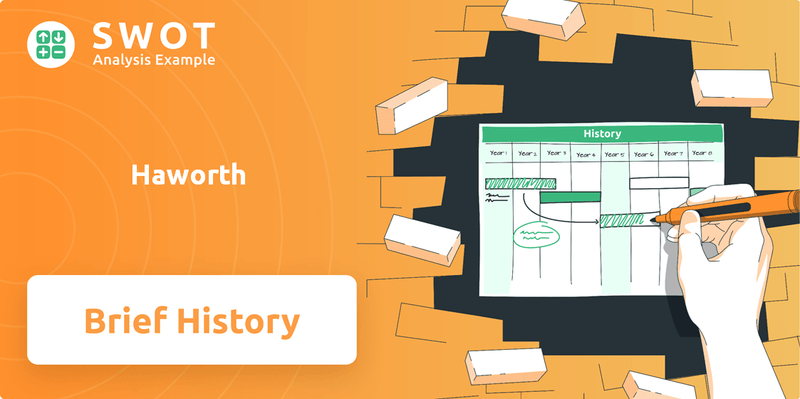
The Haworth Company's story is one of remarkable evolution, driven by a commitment to innovation and a deep understanding of evolving workplace needs. This brief history of Haworth furniture highlights key milestones, including the groundbreaking introduction of pre-wired office panels, which revolutionized office layouts. Today, Haworth's global presence and diverse product lines, from systems furniture to architectural interiors, reflect its enduring impact on the office furniture industry.
What is the Haworth Founding Story?
The story of the Haworth Company began in 1948, a venture sparked by the vision of Gerrard W. Haworth. Initially a side project, it quickly evolved into a significant player in the office furniture industry. This transformation reflects the entrepreneurial spirit and adaptability that have defined the Haworth furniture company throughout its history.
Gerrard W. Haworth, an industrial arts teacher, started the business in his garage in Holland, Michigan. He aimed to generate extra income for his children's college education. This humble beginning laid the foundation for what would become a global leader in workplace design.
To launch his woodworking business, Haworth secured a $10,000 loan from his parents' savings. Initially named Modern Products, the company's early offerings included diverse wood items such as tie racks and shoe displays. This early focus on custom wood products highlighted the company's ability to meet specific market needs, which was crucial for its initial success.
The company initially focused on special-order wood products, setting the stage for its entry into the office furniture market.
- G.W. Haworth's garage operation transitioned into a full-time business.
- The company expanded into a 4,800-square-foot plant in Holland, Michigan.
- Secured a significant contract to create movable walls for the United Auto Workers headquarters in Detroit.
- The company rebranded as Modern Partitions.
The early 1950s marked a turning point for the company. Securing a major contract to create movable walls for the United Auto Workers headquarters in Detroit propelled Haworth into the office furniture market. This pivotal moment led to the company's rebranding as Modern Partitions, reflecting its evolving focus on innovative workplace solutions.
G.W. Haworth, a graduate of Western Michigan University and the University of Michigan, brought his craftsmanship and entrepreneurial spirit to the venture. The post-WWII era's industrial boom created a demand for efficient workspaces, which Haworth was well-positioned to address. To learn more about the competitive landscape, you can explore the Competitors Landscape of Haworth.
Haworth SWOT Analysis
- Complete SWOT Breakdown
- Fully Customizable
- Editable in Excel & Word
- Professional Formatting
- Investor-Ready Format
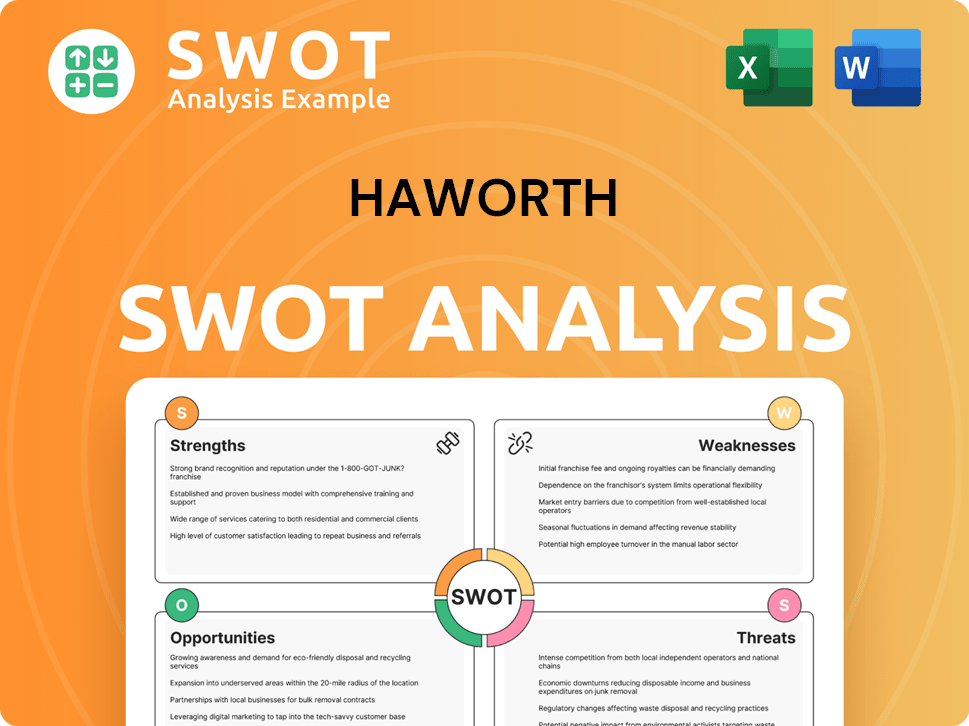
What Drove the Early Growth of Haworth?
The early years of the Haworth Company marked a significant shift from its initial focus. This Michigan company began its journey in the office furniture industry, driven by innovative designs and strategic expansions. The company's evolution is a key part of the Haworth history, showcasing its growth and impact on workplace design.
In the 1950s, the company, then known as Modern Partitions, transitioned its focus to office environments. This shift was fueled by the development of modular office partitions. A pivotal early project was the creation of an innovative office partition system for the United Auto Workers headquarters in Detroit, Michigan, which propelled the company into the movable wall products market.
Dick Haworth joined the company in 1969, eventually becoming Executive Vice President. Under his leadership, the company's name changed to Haworth, Inc. in 1976. This marked a strategic move towards exclusively producing contract office furniture. The company's focus on innovation and design helped it carve a niche in the competitive market.
A groundbreaking product launch in 1976 was the ERA-1, a pre-wired panel design that evolved into the UniGroup line. These panels could be snapped together, which eliminated the need for clients to hire electricians for wiring office spaces, streamlining the installation process. In the 1980s, Haworth furniture expanded its reach with showrooms in 18 North American cities and four international locations.
The company diversified its product offerings to include office seating and storage solutions. By 1986, Haworth had become the third-largest office furniture manufacturer in the U.S., with sales exceeding $300 million and a workforce of 2,600 employees. The strategic acquisition of 15 companies in Europe and North America, along with expanding its sales and dealer network into Asia, solidified its position as a multinational corporation. For more insights, check out Revenue Streams & Business Model of Haworth.
Haworth PESTLE Analysis
- Covers All 6 PESTLE Categories
- No Research Needed – Save Hours of Work
- Built by Experts, Trusted by Consultants
- Instant Download, Ready to Use
- 100% Editable, Fully Customizable
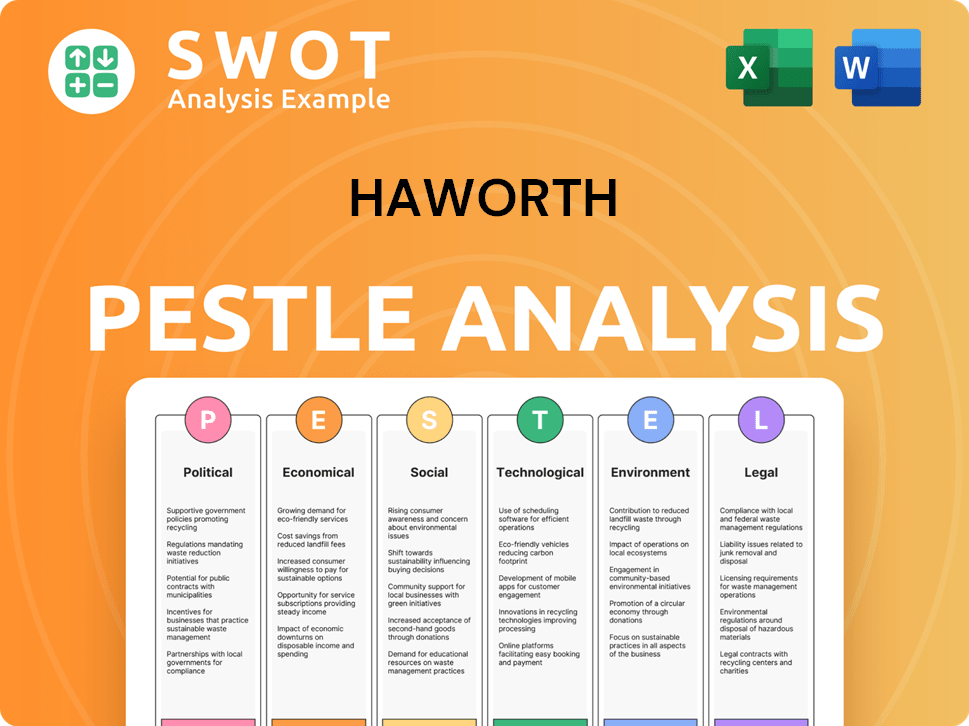
What are the key Milestones in Haworth history?
The Haworth Company's journey is marked by significant milestones, demonstrating its evolution from a small-town manufacturer to a global leader in office furniture and workplace design. This Michigan company has consistently adapted to market changes, embracing innovation and sustainability to meet the evolving needs of its customers. Understanding the Haworth history provides insights into its strategic decisions and its impact on the office furniture industry.
| Year | Milestone |
|---|---|
| 1976 | Dick Haworth invented the first cubicle wall panels with internal wiring, a groundbreaking innovation. |
| 1992 | Haworth became the first office furniture manufacturer to achieve ISO 9001 certification. |
| 1996 | Haworth won a patent infringement suit against Steelcase, receiving $211.5 million in damages and interest. |
| 2009 | Haworth achieved zero waste to landfill in all U.S. manufacturing facilities. |
| 2011 | The Haworth Collection was introduced, showcasing partnerships with renowned designers. |
| 2013 | Bluescape was launched to support virtual work and visual collaboration. |
| 2014 | Haworth acquired the Italian furniture group Poltrona Frau. |
| 2025 | A closed-loop manufacturing process for the plastic in their Fern ergonomic office chairs was announced, a first in the furniture industry. |
Haworth has consistently pushed boundaries in the office furniture sector. The company's commitment to innovation is evident through its ergonomic designs and sustainable practices.
Dick Haworth's invention of cubicle wall panels with internal wiring in 1976 revolutionized office furniture. This innovation streamlined installation and reduced costs for clients, setting a new standard in the industry.
Haworth established a research and development group dedicated to ergonomically designed furniture and office spaces. This focus aimed to enhance concentration and reduce stress in the workplace.
Haworth became the first in the contract furniture industry to achieve zero waste to landfill in all U.S. manufacturing facilities in 2009. In March 2025, they announced a closed-loop manufacturing process for the plastic in their Fern ergonomic office chairs.
Navigating a competitive market and adapting to workplace trends have been key challenges for Haworth. The company has consistently responded to these challenges through strategic acquisitions and a focus on customer-driven solutions. For more information about the company's structure, you can read about the Owners & Shareholders of Haworth.
The office furniture market is highly competitive, requiring continuous innovation and adaptation. Haworth has consistently met this challenge by focusing on design, sustainability, and customer needs.
Economic downturns can impact the office furniture industry, requiring strategic responses. Haworth has navigated these challenges through innovation, acquisitions, and a focus on customer-driven solutions.
Haworth Business Model Canvas
- Complete 9-Block Business Model Canvas
- Effortlessly Communicate Your Business Strategy
- Investor-Ready BMC Format
- 100% Editable and Customizable
- Clear and Structured Layout
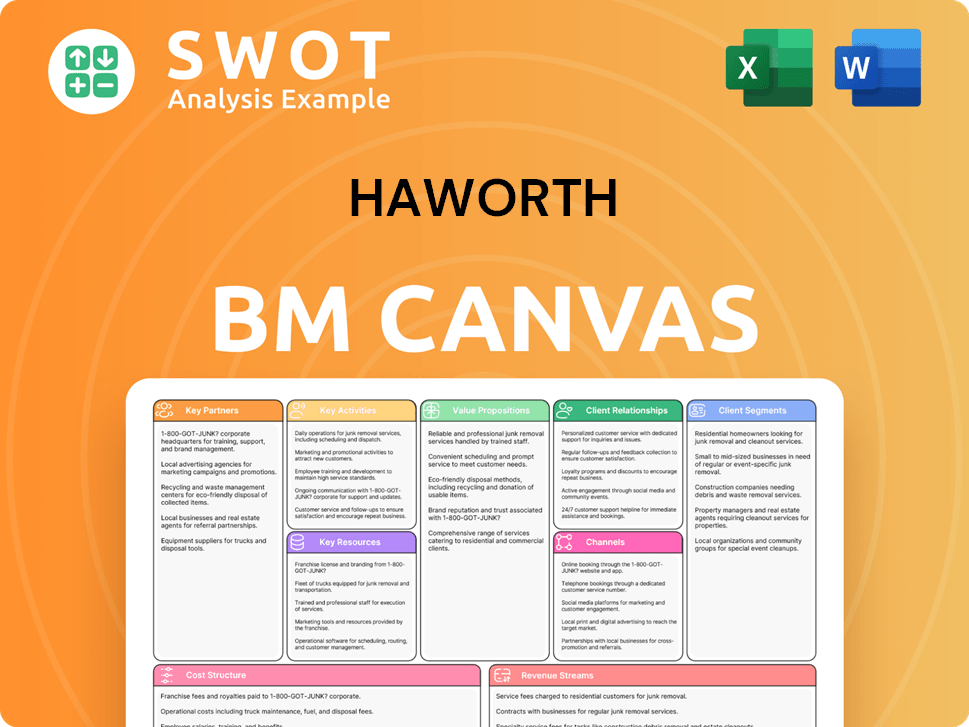
What is the Timeline of Key Events for Haworth?
The Haworth Company has a rich history, evolving from a small Michigan company into a global leader in office furniture and workplace design. From its humble beginnings in 1948, Haworth has consistently innovated, expanded its global footprint, and prioritized sustainability, shaping the modern office environment.
| Year | Key Event |
|---|---|
| 1948 | G.W. Haworth founds Modern Products in Holland, Michigan. |
| 1950s | The company shifts its focus to office partitions and is renamed Modern Partitions. |
| 1969 | Dick Haworth, G.W.'s son, joins the company. |
| 1976 | Modern Partitions becomes Haworth, Inc.; Dick Haworth patents pre-wired office panels (ERA-1). |
| 1977 | Haworth International Inc. is formed, marking the beginning of global expansion. |
| 1986 | Haworth becomes the third-largest office furniture manufacturer in the U.S. |
| 1988 | Haworth goes global, acquiring 15 companies in Europe and North America and expanding into Asia. |
| 1992 | Haworth becomes the first office furniture manufacturer to achieve ISO 9001 certification. |
| 1996 | Haworth wins a $211.5 million patent infringement lawsuit against Steelcase. |
| 2000 | Haworth surpasses $2 billion in annual revenues. |
| 2008 | A new LEED-NC Gold certified corporate headquarters opens in Holland, Michigan. |
| 2009 | Haworth achieves zero waste to landfill in all U.S. manufacturing facilities. |
| 2013 | Bluescape, a technology platform for virtual collaboration, is launched. |
| 2014 | Haworth acquires Italian furniture group Poltrona Frau. |
| 2016 | Haworth acquires outdoor furniture company JANUS et Cie. |
| 2023 | Haworth celebrates its 75th anniversary with global sales exceeding $2.5 billion. |
| 2025 (Q2) | Haworth implements a closed-loop manufacturing process for the plastic in its Fern ergonomic office chairs. |
Haworth is committed to significant reductions in emissions. The company aims to cut operational emissions by 60% and supply chain emissions by 42% by 2030, compared to 2021 levels. By 2050, they are targeting a 90% reduction in both operational and supply chain emissions, demonstrating a strong focus on sustainable Haworth furniture.
Haworth is actively working on reducing product-level emissions. Strategies include sourcing higher recycled-content and low-carbon materials. Additionally, they are creating lighter weight designs and optimizing shipping solutions to minimize environmental impact. This approach supports Haworth's dedication to sustainable workplace design.
Haworth is investing in the future of design. They are sponsoring the 2025 Design Education for ICFF, showcasing their commitment to nurturing the next generation of designers. This initiative highlights Haworth's ongoing involvement in workplace innovation and its dedication to creating innovative office furniture.
Looking ahead, Haworth is focused on continued innovation and enhancing customer experience. The company plans to expand in key markets, building on its history of creating spaces that help people perform their best. This forward-looking approach positions Haworth to maintain its leadership in the evolving landscape of global workspaces and offering modern Haworth furniture.
Haworth Porter's Five Forces Analysis
- Covers All 5 Competitive Forces in Detail
- Structured for Consultants, Students, and Founders
- 100% Editable in Microsoft Word & Excel
- Instant Digital Download – Use Immediately
- Compatible with Mac & PC – Fully Unlocked
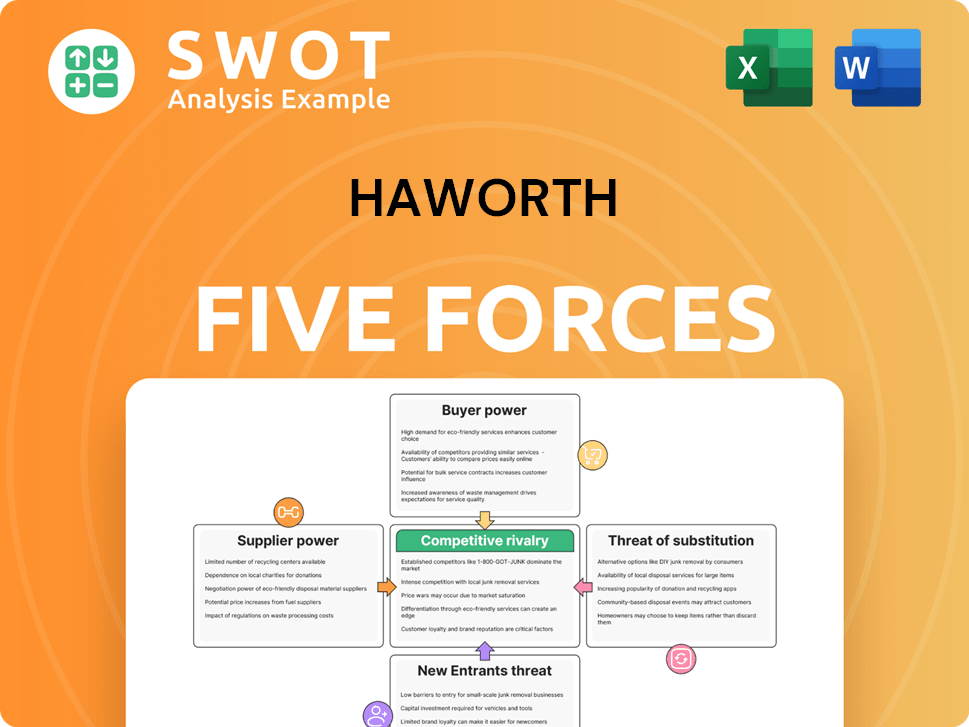
Related Blogs
- What is Competitive Landscape of Haworth Company?
- What is Growth Strategy and Future Prospects of Haworth Company?
- How Does Haworth Company Work?
- What is Sales and Marketing Strategy of Haworth Company?
- What is Brief History of Haworth Company?
- Who Owns Haworth Company?
- What is Customer Demographics and Target Market of Haworth Company?
Disclaimer
All information, articles, and product details provided on this website are for general informational and educational purposes only. We do not claim any ownership over, nor do we intend to infringe upon, any trademarks, copyrights, logos, brand names, or other intellectual property mentioned or depicted on this site. Such intellectual property remains the property of its respective owners, and any references here are made solely for identification or informational purposes, without implying any affiliation, endorsement, or partnership.
We make no representations or warranties, express or implied, regarding the accuracy, completeness, or suitability of any content or products presented. Nothing on this website should be construed as legal, tax, investment, financial, medical, or other professional advice. In addition, no part of this site—including articles or product references—constitutes a solicitation, recommendation, endorsement, advertisement, or offer to buy or sell any securities, franchises, or other financial instruments, particularly in jurisdictions where such activity would be unlawful.
All content is of a general nature and may not address the specific circumstances of any individual or entity. It is not a substitute for professional advice or services. Any actions you take based on the information provided here are strictly at your own risk. You accept full responsibility for any decisions or outcomes arising from your use of this website and agree to release us from any liability in connection with your use of, or reliance upon, the content or products found herein.